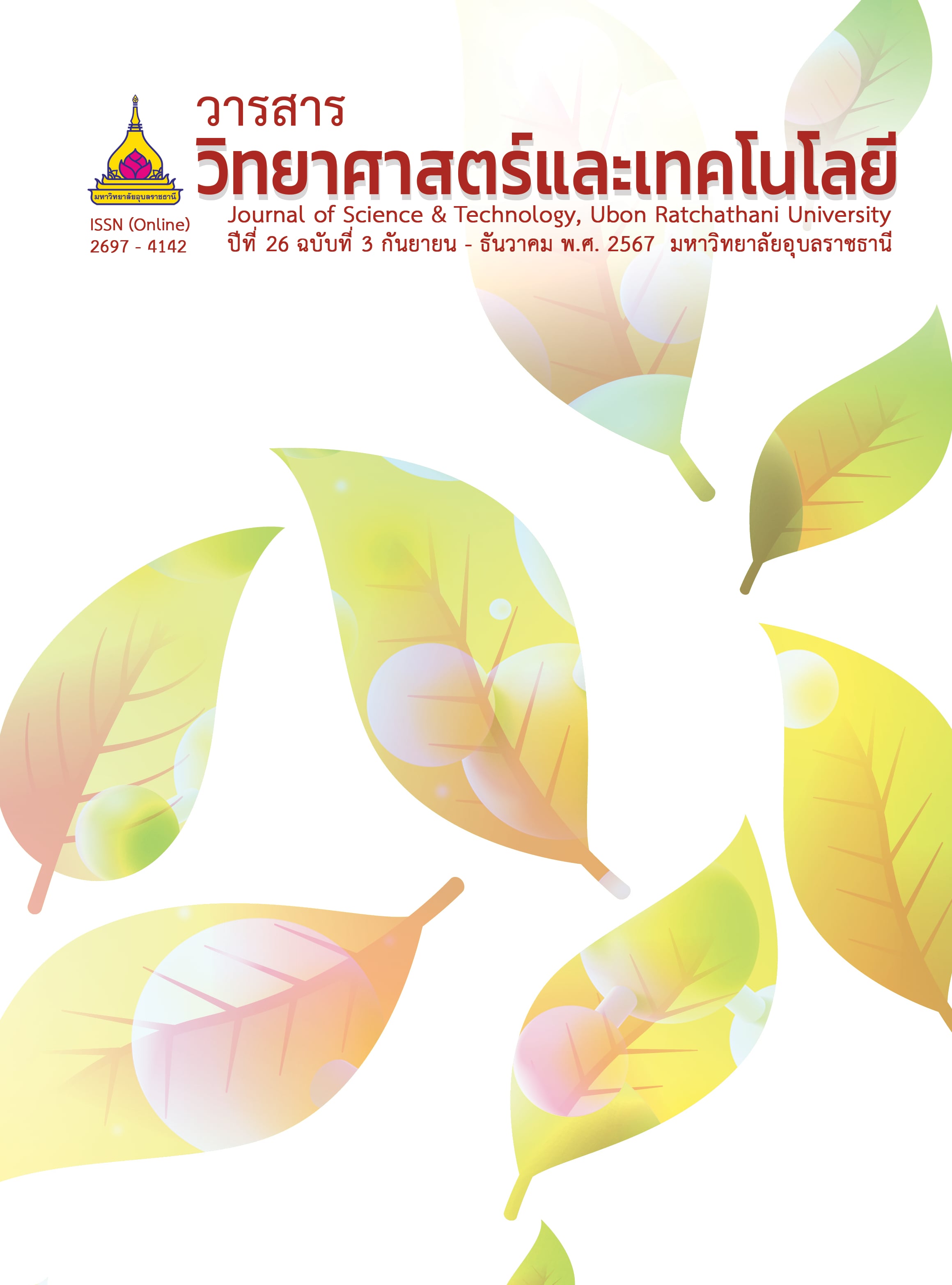การพัฒนาเจลต้านอนุมูลอิสระและต้านการอักเสบที่มีสารสกัดของสมุนไพรผสม ดอกกานพลูกับลูกจันทน์เทศ
Main Article Content
บทคัดย่อ
งานวิจัยนี้มีวัตถุประสงค์เพื่อพัฒนาเจลต้านอนุมูลอิสระและต้านการอักเสบที่มีสารสกัดของสมุนไพรผสมดอกกานพลูกับ ลูกจันทน์เทศ การเตรียมสารสกัดเอทานอลของสมุนไพรใช้วิธีการแช่หมักโดยใช้เอทานอลความเข้มข้นร้อยละ 95 เป็นตัวทำละลาย การประเมินฤทธิ์ต้านอนุมูลอิสระของสารสกัดเอทานอลของดอกกานพลู สารสกัดเอทานอลของลูกจันทน์เทศ และสารสกัดเอทานอลของสมุนไพรผสมที่มีดอกกานพลูและลูกจันทน์เทศในสัดส่วนที่เท่ากัน ใช้วิธี ABTS และ DPPH ส่วนการประเมินฤทธิ์ต้านการอักเสบของสารสกัดดังกล่าวผ่านการยับยั้งการสร้างไนตริกออกไซด์ ใช้วิธี Griess ผลการศึกษา พบว่า สารสกัดของสมุนไพรผสมดอกกานพลูกับลูกจันทน์เทศมีฤทธิ์ยับยั้งอนุมูลอิสระ ABTS•+ และ DPPH• ที่สูง โดยมีค่า IC50 เท่ากับ 0.35±0.01 และ 0.08±0.01 มิลลิกรัมต่อมิลลิลิตร ตามลำดับ และมีความสามารถในการยับยั้งการสร้างไนตริกออกไซด์ โดยมีค่า IC50 เท่ากับ 0.19±0.01 มิลลิกรัมต่อมิลลิลิตร หลังจากที่นำสารสกัดของสมุนไพรผสมดอกกานพลูกับลูกจันทน์เทศมาพัฒนาเป็นเจลสมุนไพรที่ความเข้มข้นของสารสกัดร้อยละ 0.05, 0.10 และ 0.20 โดยน้ำหนัก แล้วศึกษาความคงตัวของเจลสมุนไพรในสภาวะเร่ง ด้วยวิธี heat-cool cycling method และประเมินฤทธิ์ต้านอนุมูลอิสระ และฤทธิ์ต้านการอักเสบของเจลสมุนไพรด้วยวิธีที่กล่าวมาข้างต้น ผลการศึกษา พบว่า เจลสมุนไพรทุกสูตรมีความคงตัวดี ไม่มีการเปลี่ยนแปลงลักษณะทางกายภาพและทางเคมี นอกจากนี้ยังพบว่าเจลสมุนไพรทุกสูตรมีฤทธิ์ต้านอนุมูลอิสระ และฤทธิ์ต้านการอักเสบที่เทียบเท่ากับเจลมาตรฐานไดโคลฟีแนค ความเข้มข้นร้อยละ 1 ดังนั้นเจลที่มีสารสกัดของสมุนไพรผสมดอกกานพลูกับลูกจันทน์เทศทุกสูตรในการศึกษานี้จึงมีศักยภาพที่จะนำไปพัฒนาเป็นผลิตภัณฑ์สมุนไพรที่มีฤทธิ์ต้านอนุมูลอิสระ และฤทธิ์ต้าน การอักเสบต่อไป
Article Details

อนุญาตภายใต้เงื่อนไข Creative Commons Attribution-NonCommercial-NoDerivatives 4.0 International License.
บทความที่ได้รับการตีพิมพ์เป็นลิขสิทธิ์ของ วารสารวิทยาศาสตร์และเทคโนโลยี มหาวิทยาลัยอุบลราชธานี
ข้อความที่ปรากฏในบทความแต่ละเรื่องในวารสารวิชาการเล่มนี้เป็นความคิดเห็นส่วนตัวของผู้เขียนแต่ละท่านไม่เกี่ยวข้องกับมหาวิทยาลัยอุบลราชธานี และคณาจารย์ท่านอื่นๆในมหาวิทยาลัยฯ แต่อย่างใด ความรับผิดชอบองค์ประกอบทั้งหมดของบทความแต่ละเรื่องเป็นของผู้เขียนแต่ละท่าน หากมีความผิดพลาดใดๆ ผู้เขียนแต่ละท่านจะรับผิดชอบบทความของตนเองแต่ผู้เดียว
เอกสารอ้างอิง
Saxena, A. and et al. 2015. Myofascial pain syndrome: an overview. Journal of Pain and Palliative Care Pharmacotherapy. 29(1): 16-21.
Mense, S. 2003. The pathogenesis of muscle pain. Current Pain and Headache Reports. 7(6): 419-425.
Closa, D. and Folch-Puy, E. 2004. Oxygen free radicals and the systemic inflammatory response. IUBMB Life. 56(4): 185-191.
Bindu, S., Mazumder, S. and Bandyopadhyay, U. 2020. Non-steroidal anti-inflammatory drugs (NSAIDs) and organ damage: a current perspective. Biochemical Pharmacology. 180: 114147.
Golmakani, M.T., Zare, M. and Razzaghi, S. 2017. Eugenol enrichment of clove bud essential oil using different microwave-assisted distillation methods. Food Science and Technology Research. 23(3): 385-394.
Kennouche, A. and et al. 2015. Chemical composition and antimicrobial activity of the essential oil of Eugenia caryophyllata Cloves extracted by conventional and microwave techniques. Journal of Biologically Active Products from Nature. 5(1): 1-11.
Gonzalez-Rivera, J. and et al. 2016. Coaxial microwave assisted hydrodistillation of essential oils from five different herbs (lavender, rosemary, sage, fennel seeds and clove buds): chemical composition and thermal analysis. Innovative Food Science and Emerging Technologies. 33: 308-318.
Wuttidhammaved, W. 2007. The Rattanakosin Pharmacy Ancient Book. Bangkok: Odeon store. (in Thai)
Dahham, S. and et al. 2015. The anticancer, antioxidant and antimicrobial properties of the sesquiterpene ß-caryophyllene from the essential oil of Aquilaria crassna. Molecules. 20(7): 11808-11829.
Ramadan, M.M. and et al. 2015. Essential oils from Egyptian aromatic plants as antioxidant and novel anticancer agents in human cancer cell lines. Grasas y Aceites. 66(2): e080.
Haro-Gonzalez, J.N. and et al. 2021. Clove essential oil (Syzygium aromaticum L. Myrtaceae): extraction, chemical composition, food applications, and essential bioactivity for human health. Molecules. 26(21): 1-25.
Ashokkumar, K. and et al. 2022. Nutmeg (Myristica fragrans Houtt.) essential oil: a review on its composition, biological, and pharmacological activities. Phytotherapy Research. 36(7): 2839-2851.
Nualkaew, S. 2020. Applied Thai Traditional Pharmacy. Khon Kaen: Khon Kaen University Printing House. (in Thai)
Ohn-on, W. and et al. 2022. Effects of extraction methods on total phenolic content and antioxidant activity of Chan-Tang-Ha recipe. Journal of Science and Technology, Ubon Ratchathani University. 24(3): 88-96. (in Thai)
Sriset, Y., Chatuphonprasert, W. and Jarukamjorn, K. 2021. In vitro antioxidant potential of Mallotus repandus (Willd.) Muell. Arg stem extract and its active constituent bergenin. Songklanakarin Journal of Science and Technology. 43(1): 24-30.
Khan, A.W. and et al. 2013. Formulation development, optimization and evaluation of aloe vera gel for wound healing. Pharmacognosy Magazine. 9(Suppl. 1): S6-S10.
Ijaz, N. and et al. 2022. Formulation and characterization of aloe vera gel and tomato powder containing cream. Acta Ecologica Sinica. 42(2): 34-42.
El Ghallab, Y. and et al. 2020. Syzygium aromaticum L.: phytochemical investigation and comparison of the scavenging activity of essential oil, extracts and eugenol. Advances in Traditional Medicine. 20: 153-158.
Li, Y. and et al. 2022. Chemical compositions of clove (Syzygium aromaticum (L.) Merr. & L.) extracts and their potentials in suppressing SARS-CoV-2 spike protein-ACE2 binding, inhibiting ACE2, and scavenging free radicals. Journal of Agricultural and Food Chemistry. 70(45): 14403-14413.
Temesgen, S., Sasikumar, J.M. and Egigu, M.C. 2022. Effect of extraction solvents on total polyphenolic content and antioxidant capacity of Syzygium aromaticum L. flower bud from Ethiopia. BioMed Research International. 2022: 4568944.
Li, C.W. and et al. 2020. Evaluation of antioxidant and anti-α-glucosidase activities of various solvent extracts and major bioactive components from the seeds of Myristica fragrans. Molecules. 25(21): 5198.
Champasuri, S. and Itharat, A. 2016. Bioactivities of ethanolic extracts of three parts (wood, nutmeg and mace) from Myristica fragrans Houtt. Journal of the Medical Association of Thailand. 99(Suppl. 4): S124-S130.
Ali, S.M. and Yosipovitch, G. 2013. Skin pH: from basic science to basic skin care. Acta Dermato-Venereologica. 93(3): 261-267.
Ikhsanudin, A., Lolita, L. and Rais, D.D. 2021. Anti-inflammatory activity of Indonesian nutmeg seeds (Myristica fragrans Houtt): a topical gel formulation. International Journal of Public Health Science. 10(3): 689-695.
Sugihartini, N., Lestari, G. and Yuliani, S. 2019. Anti-inflammatory activity of essential oil of clove (Syzygium aromaticum) in O/W and W/O creams. Pharmaciana. 9(1): 109-118.


